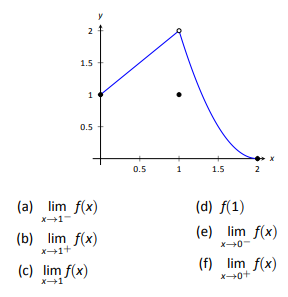1.E: Applications of Limits (Exercises)
( \newcommand{\kernel}{\mathrm{null}\,}\)
1.1: An Introduction to Limits
Terms and Concepts
- In your own words, what does it mean to "find the limit of
- An expression of the form
- T/F: The limit of
- Describe three situations where
- In your own words, what is a difference quotient.
Problems
In Exercises 6-16, approximate the given limits both numerically and graphically.
6.
7.
8.
9.
10.
11.
12.
13.
14.
15.
In Exercises 16-24, a function
16.
17.
18.
19.
20.
21.
22.
23.
1.2: Epsilon-Delta Definition of a Limit
Terms and Concepts
1. What is wrong with the following "definition" of a limit?
"The limit of
2. Which is given first in establishing a limit, the x-tolerance or the y-tolerance?
3. T/F:
4. T/F:
Problems
In Exercises 5-11, prove the given limit using an
5.
6.
7.
8.
9.
10.
11.
1.3: Finding Limits Analytically
Terms and Concepts
1. Explain in your own words, without using
2. Explain in your own words, without using
3. What does the text mean when it says that certain functions’ “behavior is ‘nice’ in terms of limits”? What, in particular, is “nice”?
4. Sketch a graph that visually demonstrates the Squeeze Theorem.
5. You are given the following information:
(a)
(b)
(c)
What can be said about the relative sizes of
Problems
Using:
evaluate the limits given in Exercises 6-13, where possible. If it is not possible to know, state so.
6.
7.
8.
9.
10.
11.
12.
13.
Using
evaluate the limits given in Exercises 14-17, where possible. If it is not possible to know, state so.
14.
15.
16.
17.
In Exercises 18-32, evaluate the given limit.
18.
19.
20.
21.
22.
23.
24.
25.
26.
27.
28.
29.
30.
31.
32.
Use the Squeeze Theorem in Exercises 33-36, where appropriate, to evaluate the given limit.
33.
34.
35.
36.
Exercises 37-40, challenge your understanding of limits but can be evaluated using the knowledge gained in this section.
37.
38.
39.
40.
1.4: One Sided Limits
Terms and Concepts
1. What are the three ways in which a limit may fail to exist?
2. T/F: If
3. T/F: If
4. T/F: If
Problems
In Exercises 5-12, evaluate each expression using the given graph of
5.

6.
7.
8.
9.
10.
11.
12.
In Exercises 13-21, evaluate the given limits of the piecewise defined functions
13.
(a)
(b)
(c)
(d)
14.
(a)
(b)
(c)
(d)
15.
(a)
(b)
(c)
(d)
(e)
(f)
(g)
(h)
16.
(a)
(b)
(c)
(d)
17.
(a)
(b)
(c)
(d)
18.
(a)
(b)
(c)
(d)
19.
(a)
(b)
(c)
(d)
20.
(a)
(b)
(c)
(d)
21.
(a)
(b)
(c)
(d)
Review
22. Evaluate the limit:
23. Evaluate the limit:
24. Evaluate the limit:
25. Approximate the limit numerically:
26. Approximate the limit numerically:
1.5: Continuity
Terms and Concepts
1. In your own words, describe what it means for a function to be continuous.
2. In your own words, describe what the Intermediate Value Theorem states.
3. What is a “root” of a function?
4. Given functions
5. T/F: If
6. T/F: If
7. T/F: If
8. T/F: If
9. T/F: If f is continuous on [0, 1) and [1, 2), then
10. T/F: The sum of continuous functions is also continuous.
Problems
In Exercises 11-17, a graph of a function
11.
12.
13.
14.
15.
16.
17.
(a)
(b)
(c)
In Exercises 18-21, determine if
18.
(a)
(b)
19.
(a)
(b)
20.
(a)
(b)
21.
(a)
(b)
In Exercises 22-32, give the intervals on which the given function is continuous.
22.
23.
24.
25.
26.
27.
28.
29.
30.
31.
32.
33. Let
34. Let
35. Let
36. Let
In Exercises 37-40, use the Bisection Method to approximate, accurate to two decimal places, the value of the root of the given function in the given interval.
37.
38.
39.
40.
Review
41. Let
(a)
(b)
(c)
(d)
42. Numerically approximate the following limits:
(a)
(b)
43. Give an example of function
1.6: Limits Involving Infinity
Terms and Concepts
1. T/F: If
2. T/F: If
3. T/F: If
4. T/F: If
5. T/F:
6. List 5 indeterminate forms.
7. Construct a function with a vertical asymptote at x = 5 and a horizontal asymptote at y = 5.
8. Let
Problems
In Exercises 9-14, evaluate the given limits using the graph of the function.
9.
(a)
(b)
10.
(a)
(b)
(c)
(d)
(e)
(f)
11.
(a)
(b)
(c)
(d)
12.
(a)
(b)
13.
(a)
(b)
14.
(a)
(b)
In Exercises 15-18, numerically approximate the following limits:
(a)
(b)
(c)
15.
16.
17.
18.
In Exercises 19-24, identify the horizontal and vertical asymptotes, if any, of the given function.
19.
20.
21.
22.
23.
24.
In Exercises 25-28, evaluate the given limit.
25.
26.
27.
28.
Review
29. Use an
30. Let
(a)
(b)
(c)
(d)
31. Let
32. Evaluate the limit:

